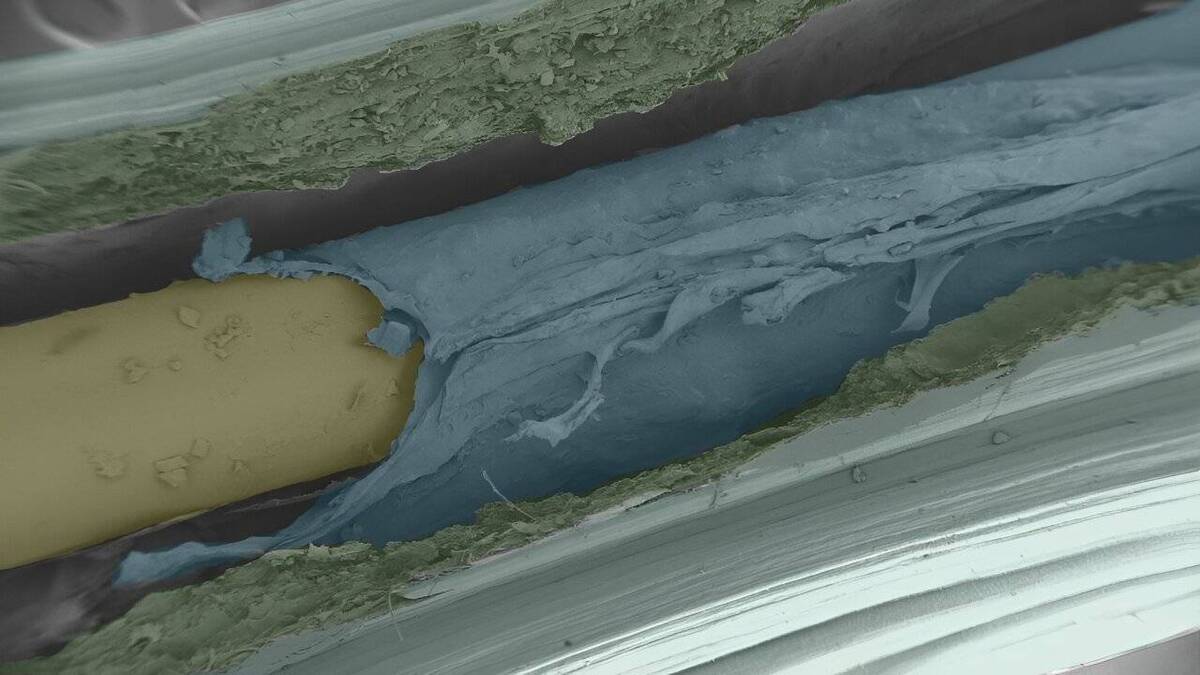Revolutionary Concrete from Drexel Melts Snow, Ice Naturally

Drexel researchers show concrete with phase-change material can warm itself when temperatures fall. There’s a patch of concrete on Drexel University’s campus that could portend a frost-free future for sidewalks and highways in the Northeast, the Journal of Materials in Civil Engineering reported.
Tucked inconspicuously next to a parking lot for the university’s facilities vehicles, two 30-inch-by-30-inch slabs have been warding off snow, sleet and freezing rain on their own — without shoveling, salting or scraping — for a little over three years. Researchers in Drexel’s College of Engineering, recently reported on the science behind the special concrete, that can warm itself up when it snows, or as temperatures approach freezing.
Self-heating concrete, like Drexel’s, is the latest in an ongoing effort to create more environmentally responsive and resilient infrastructure, particularly in the northern regions of the United States, where the National Highway Administration estimates states spend $2.3 billion on snow and ice removal operations each year and millions to repair roadways damaged by winter weather.
“One way to extend the service life of concrete surfaces, like roadways, is to help them maintain a surface temperature above freezing during the winter,” said Amir Farnam, PhD, an associate professor in the College of Engineering whose Advanced Infrastructure Materials Lab has been leading the research. “Preventing freezing and thawing and cutting back on the need for plowing and salting are good ways to keep the surface from deteriorating. So, our work is looking at how we can incorporate special materials in the concrete that help it to maintain a higher surface temperature when the ambient temperature around it drops.”
The Drexel team has been developing its cold-weather-resilient concrete mix over the last five years with the goal of reducing the freezing, thawing, and salting that eats away at roads and other concrete surfaces. Until now, the success of their self-heating concrete — which they have previously reported can melt snow and prevent or slow ice formation for an extended period of time — has only been in a controlled lab setting. In a paper recently published in the American Society for Civil Engineering’s Journal of Materials in Civil Engineering, the group took the important step of proving its viability in the natural environment.
“We have demonstrated that our self-heating concrete is capable of melting snow on its own, using only the environmental daytime thermal energy — and doing it without the help of salt, shoveling, or heating systems,” Farnam said. “This self-heating concrete is suitable for mountainous and northern regions in the U.S., such as Northeast Pennsylvania and Philadelphia, where there are suitable heating and cooling cycles in winter.”
The secret to the concrete’s warming is low-temperature liquid paraffin, which is a phase-change material, meaning it releases heat when it turns from its room-temperature state — as a liquid — to a solid, when temperatures drop. In a previous paper, the group reported that incorporating liquid paraffin into the concrete triggers heating when temperatures drop. Their latest research looks at two methods for incorporating the phase-change material in concrete slabs and how each fare outside in the cold.
One method involves treating porous lightweight aggregate — the pebbles and small stone fragments that are ingredients in concrete — with the paraffin. The aggregate absorbs the liquid paraffin before being mixed into the concrete. The other strategy is mixing micro-capsules of paraffin directly into the concrete.
The researchers poured one slab using each method and a third without any phase-change material, as a control. All three have been outside in the elements since December 2021. In the first two years, they faced a total of 32 freeze-thaw events — instances where the temperature dropped below freezing, regardless of precipitation — and five snowfalls of an inch or more.
Using cameras and thermal sensors, the researchers monitored the temperature and snow and ice-melting behavior of the slabs. They reported that the phase-change slabs maintained a surface temperature between 42 and 55 degrees Fahrenheit for up to 10 hours, when air temperatures dipped below freezing.
This heating is enough to melt a couple of inches of snow, at a rate of about a quarter of an inch of snow per hour. And while this may not be warm enough to melt a heavy snow event before plows are needed, it can help deice the road surface and increase transportation safety, even in heavy snow events.
Simply preventing the surface from dropping below freezing also goes a long way when it comes to preventing deterioration, according to the researchers.
“Freeze-thaw cycles, periods of extreme cooling – below freezing – and warming, can cause a surface to expand and contract in size, which puts a strain on its structural integrity and can cause damaging cracking and spalling over time,” said Robin Deb, a doctoral student in the College of Engineering, who helped to lead the research. “And while this alone may not degrade the structure to the point of failure, it creates a vulnerability that will lead to the problematic interior deterioration that we need to avoid. One of the promising findings is that the slabs with phase-change materials were able to stabilize their temperature above freezing when faced with dropping ambient temperatures.”
Overall, the treated lightweight aggregate slab performed better at sustaining its heating — keeping the temperature above freezing for up to 10 hours — while the slab with microencapsulated phase-change material was able to heat up more quickly, but only maintain the warming for half as long. The researchers suggest this is due to the relative disbursal of the phase-change material within the pores of the aggregate, by comparison to the concentration of phase-change material inside the microcapsules — a phenomenon that has been studied extensively.
They also noted that the porosity of the aggregate likely contributes to the paraffin remaining a liquid below its usual freezing temperature of 42 degrees Fahrenheit. This proved beneficial to the slab’s performance because the material did not immediately release its heat energy when the temperature began to drop — holding its release until the material reached 39 degrees Fahrenheit. By contrast, the microencapsulated paraffin began releasing its warming energy as soon as its temperature reached 42 degrees, which contributed to its relatively shorter activation period.
“Our findings suggest that the phase-change material treated lightweight aggregate concrete was more suited for deicing applications at sub-zero temperatures due to its gradual heat release within wider range of temperature,” Farnam said.
While both applications were able to raise the temperature of the concrete to between 53 and 55 degrees Fahrenheit, which is more than enough to melt snow. Their performance was affected by the ambient air temperature before a snowfall and the rate of snowfall.
“We found that PCM-incorporated pavements cannot completely melt heavy snow accumulation — larger than 2 inches,” Deb said. “It can, however, melt snowfalls less than two inches quite effectively. The PCM-incorporated slabs begin melting snow as soon as it starts to accumulate. And the gradual heat release can effectively deice a pavement’s surface, which would eliminate the need to pre-salt before the heavy snowfall.”
They also noted that if the phase-change material does not have some time to “recharge” by warming enough to return to its liquid state between freeze-thaw or snow events, then its performance may be diminished.
“Conducting this research was an important step for us to understand how concrete incorporating phase-change material behaves in nature,” Deb said. “With these findings, we will be able to continue to improve the system to one day optimize it for longer heating and greater melting. But it is encouraging to see evidence of significant reduction of freeze-thaw cycles, which demonstrates that PCM concrete is more freeze-thaw durable compared to traditional concrete.”
The team plans to continue to collect data on the slabs to understand the long-term effectiveness of the phase-change materials and study how this method may extend the lifespan of concrete.
4155/v
























